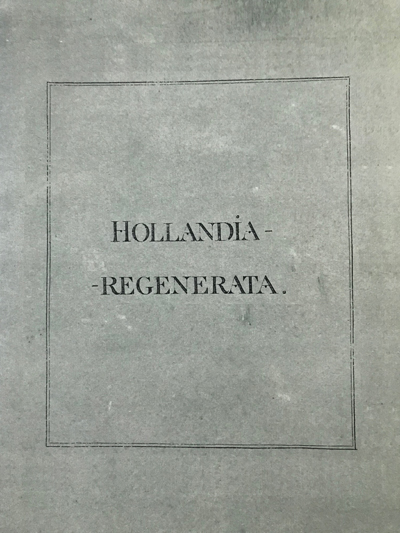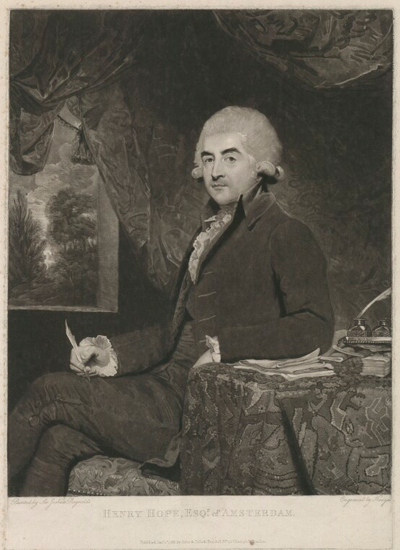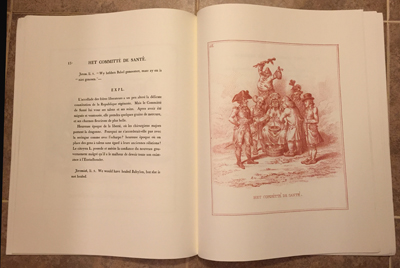Hollandia Regenerata: Introduction
Hollandia Regenerata is a twenty plate series mocking the newly created Batavian Republic established in Holland in 1795 by Dutch Patriots with the help of French revolutionaries. The set of prints was designed and drawn by the Swiss amateur caricaturist David Hess, etched by Gillray, and first published in London, probably in the autumn of 1796.
It was then circulated in Holland and elsewhere in Europe with the hope of undermining French plans for revolutionary expansion. Although some of the figures in the prints are based upon real Dutch politicians, the focus on the incompetence and hypocrisy of the administrators of the new Republic was generic enough to be applicable to a potential French invasion of other countries outside Holland. Indeed an Italian version of the set, La Rigenerazione dell' Olanda, was published in Venice by Giovanni Zatta in 1799. And in England it was also the inspiration for what was intended to be another 20 plate series initiated by Sir John Dalrymple in 1798. See my Introduction to the Consequences of a Successful French Invasion for an overview of that effort.
From here you can go directly to the first of 20 commentaries on specific plates, or you can continue below to learn more about David Hess and the political and artistic context in which the series was created.

Uitgeverij Vantilt, 2007
David Hess
The creator of Hollandia Regenerata, David Hess, was born on the Swiss Beckenhof estate belonging to his parents in the small town of Unterstrass not far from Zurich. Although he had a passion for poetry and painting and a knack for caricature, Hess was brought up to follow a military career like his father. The Swiss had an agreement with the United Provinces of the Netherlands to provide mercenary troops to Holland in times of need so by the time he was sixteen, David found himself in the Netherlands as part of the Swiss Guard assigned to the protection of the Stadtholder. After the French declaration of war against the United Provinces, Hess saw action against combined French and Patriot (Batavian) troops along side Prince Frederick, the younger son of Stadholder William V, Prince of Orange. But, most of the time, he was stationed in The Hague near the Orangist seat of government.
When William V fled to England in January of 1795 and a Batavian Republic was proclaimed, the position of foreign mercentaries was now problematic. In July 1795, the new governing body, the Provisional Representatives of the People of Holland, decided that foreign troops like the Swiss Guard should be sent home. But it was not until seven months later in Febuary 1796 that the official order of dismissal was issued. During those thirteen months from January 1795 until February 1796, Hess had a first hand look at the people and policies of the new Republic which formed the basis of Hollandia Regenerata, and it is likely that most of the drawings were sketched, if not fully completed, at that time.
According to Joost Rosendaal whose "Nawoord" to his facsimile edition of a Hollandia Regenerata is essential reading for anyone interested in the series, Hess was unhappy about being summarily cast off by the Dutch, complaining in a letter quoted by Rosendaal: ""The ending is such as one would have expected from the most narrow-minded and ungrateful people on earth, for whom we served all too well and too truly at the risk of our lives."
It was at this time, as Hess explains in a letter quoted by Rosendaal, that he probably obtained a list of the sixteen new administrative "Comites" established by the Provisional Representatives. Twelve of them are satirized in Hollandia Regenerata. Four were left untouched. But Hess invented additional committees as well as additional plates to represent other abuses that he wished to castigate. The table below lists the title and print number of Hollandia Regenerata plate and the corresponding object of Hess's satire.
| HR Plate Number and Name | Object of Satire |
|---|---|
| Plate 1 Frontispiece: Dansons la Camagnole! Let's Dance the Carmagnole! |
Deluded Dutch Citizens |
| Plate 2 Het Committé van Algemeen Welzyn [The Committee of General Well Being] |
Comité van Algemeen Welzyn |
| Plate 3 Het Commité Militair [The Military Committee] |
Reorganization of the Military |
| Plate 4 Het Commité van Financie [The Finance Committee] |
Paper Money |
| Plate 5 Het Commité van Rekening [The Accounting Committee] |
Financial Incompetence and Malfeasance |
| Plate 6 Het Commité van Koophandel en Zeevaart [The Committee of Commerce and Shipping] |
Results of the Revolution upon Commerce |
| Plate 7 Het Commité van de Vivres [The Committee of Rations and Necessities] |
Results of French Requisitions |
| Plate 8 Het Committé van Algemeen Waakzaamheid [The Committtee of General Vigilance] |
The Lack of Attention to Potential Dangers |
| Plate 9 Het Commité van Voorlichting The Illumination Committee |
The Difficulties of Revolutionary Enlightenment |
| Plate 10 Het Commité der Hooge, Laagen en Midelbaare Heerlykheeden The Committee of High, Low, and Middle Class |
The Hypocrisy of the Committee. |
| Plate 11 Committé van Noodlydende The Committee of the Distressed |
Comité van Noodlijdenden |
| Plate 12 Het Commité van Uitgewekenen [The Refugee Committee] |
Comité van Uitgewekenen |
| Plate 13 Het Committé van Buitelandsche Zaaken [The Committee for Foreign Affairs] |
Lack of Vision of the Committee Distorted by French Influence |
| Plate 14 Het Commité van Fransche Requisitien [The Committee of French Requisitions] |
French Predatory Demands |
| Plate 15 Het Commité de Santé The Committee of Health |
The Ill Health of the Country |
| Plate 16 Het Commité van Remotie The Removal Committee |
Desecration of Nassau-Orange Graves |
| Plate 17 Het Commité van Bondgenootschap The Confederation Committee |
In-fighting among the Provincial Representatives |
| Plate 18 Eenige der Representanten van het Volk van Holland [Some of the Representatives of the People of Holland] |
Growing Violence and Strife |
| Plate 19 De Nationale Conventie in Barensnood van Eene Constitutie [The National Convention in Labor with a Constitution] |
Difficulties in Crafting a New Constitution |
| Plate 20 Past Op!!! [Watch Out!!!] |
Beware of the Future |
The four actual committees NOT satirized by Hess included:
- Comité Oost-Indishe Compagnie [East-India Company Committee]
- Comité Examinatie van Rekesten [Petitions Review Committee]
- Comité Zeedijken en Zeeweringen [Committee of Marine Dykes and Defenses
- Comité Grote Visserij [Large Fisheries Committee]
The Comité Oost-Indishe Compagnie may have been spared because of its close association with Sir Francis Baring, one of the possible funders of Hollandia Regenerata.
The Production of Hollandia Regenerata
The path to the production of Hollandia Regenerata is complex and, at this point, somewhat speculative. Further research would be required to uncover the actual steps along that path. Most English commentators, following Draper Hill, who in turn based his assumptions upon a letter to Gillray from Sir John Dalrymple, assume that funding for the production of Hollandia Regenerata came from Francis Baring and Commander William Hope.
But as his negotiations with Gillray over the 1798 series, Consequences of a Successful French Invasion show, Dalrymple was notoriously unreliable: greatly underestimating the expense of print-making, greatly over-estimating the willingness of the Pitt government to support his own plans for a satire of twenty prints, and more than likely misrepresenting or misunderstanding the origins and implementation of Hollandia Regenerata.
In his prospectus for the Consequences of a Successful French Invasion, Dalrymple wrote:
During the present Revolutions of Holland a Series of Engravings was published, which containing a Succession of Events, and Consequences from them, formed a Kind of History whereby Men were taught their Duty in public Life by their Fears and their Dangers. Twelve thousand Copies were circulated in that Country, at a trifling Expense. The Antidote, however, came too late for the Poison.
But this much-quoted assertion is almost certainly a gross exaggeration in two respects. Print runs of satiric prints of two to five hundred were not uncommon, but a run of even a thousand would have been rare. A run of twelve thousand would have been impossible. And to what point? Hollandia Regenerata is unusual as satiric prints go because it relies more than most upon text. And in this case, that text is in three different languages—French, Dutch, and English. As Rosendaal points out, its audience was not the average man on the street but an elite group of well-educated individuals who could understand several languages and appreciate the subtle humor of its images. And that audience would have numbered in the hundreds, not the thousands.
And even if the print run was in the hundreds, the expense of Hollandia Regenerata would hardly have been "trifling." First of all the book itself was large—11-1/2 x 14-1/2 inches, approximately folio size. And each of the 20 prints was accompanied by a page of commentary, making the entire book upwards of 40 pages. It was printed on fine paper in red or sometimes black ink with a cover you can see in the facsimile above. And that means that Hollandia Regenerata must have had some significant financial backing. But here again, Dalrymple is probably confused.
According to Rosendaal, it was a friend of Hess's, Johann Friedrich Euler (1741-1800), who first recognized the potential of the drawings. A mathematician, Euler had been a tutor for the Stadtholder's children, but remained in close contact with the family even though the children were now grown. Hess had loaned him the drawings as entertainment while Euler recovered from an illness. Greatly amused, Euler began circulating the drawings among supporters of the Stadtholder, including the ousted regent Robert Bonte. It was Bonte, according to Rosendaal, who first approached the wealthy Peter C. Labouchere about getting them printed. Labouchere was a partner in the huge Amsterdam-based mercantile banking house of Hope and Co. The head of the company, Henry (not Wiliam) Hope had fled the country for England in October 1794, about three months before the Stadtholder, taking along a painting collection of over 300 works by artists like Hals, Rembrandt, Rubens, and Van Dyke which he (rightly) feared would be confiscated by the French. Labouchere initially remained in Amsterdam while Hope set up new offices for the company in London. Given their recent experiences, it would not be surprising that Hope and Labouchere might want to help a project that would undermine the French-supported Republic and result in the return of the Stadtholder.
Without explaining how, Rosendaal also suggests that it was through Labouchere that the drawings reached William Humphrey and Gillray. But I think we can now see how it might have happened. Since Labouchere was still in Amsterdam and Hope already in London, Labouchere would have had regular correspondence with Hope. And since any significant funding for a Hollandia project woud have needed Hope's approval, Labouchere would likely have forwarded the drawings to Hope for examination.
William Humphrey had a reputation in Holland as both an engraver and printseller. As early as 1765, he was responsible for creating a mezzotint based on a self-portrait of Rembrandt. And on one of many trips to Holland as a printseller gave Charles Howard Hodges, the young painter/engraver, who later created a well-known mezzotint of Henry Hope, his first introduction to the Netherlands. Once established in Amsterdam Hodges created numerous portraits of the Dutch elite including members of the Stadtholder's family and, according to Rosendaal, also acted as an in-country agent for Humphrey. In that capacity he would have wanted to alert Humphrey to potential business opportunities in the region, and the possibiity of creating prints based on the Hollandia drawings was an opportunity that would have seemed tailor made for Humphrey's abiities and connections. And if Humphrey was in Amsterdam on business, he might even have served as courier himself, or at minimum have been consulted on the transfer since he was obviously famiiar with shipping art works from Amsterdam to London.

Charles Howard Hodges after Joshua Reynolds
© National Portrait Gallery, London
From as early as the 1760s, Hope and Co. had been doing business with the great English mercantile banker, Sir Francis Baring. In the collection of what is called the "Northbrook Business Papers" in the Baring Archive, there is voluminous correspondence between the two men and their companies concerning joint projects in Russia and America and the expected flight of Henry Hope to London which had been planned for a full year before it took place. The actual arrival of Hope in London in October 1794 must have made made the association just that much stronger. And the link was further strengthened by the engagement in November of 1796 of Hope's business partner, Peter Labouchere, with the Baring's third daughter, Dorothy. Since the two men often collaborated on on projects that served their personal and financial interests, it is not unlikely that Baring would have been aware of Hollandia Regenerata, and perhaps shared some financial reponsibiity. But it was always Hope and Company that had the greater stake in its success.
Gillray's Contribution
Gillray fans may be initially disappointed to see how little of the design of the Hollandia Regenerata plates can be attributed to Gillray. For I have purposely included, in my individual commentaries on each plate, the Hess drawings that Gillray used as source (many thanks to Zentralbibliothek Zürich). But it is perhaps too easy to forget that Gillray was a businessman in his own right. He made his living with his pen, his burin and his etching needle. That meant finding jobs that demanded his skills and would pay for them. And as all freelancers understand, this also meant doing the job that he was asked to do. In the case of Hollandia Regenerata the task was to make memorable and reproducible prints based on Hess's drawings. And Gillray did that superbly. Every plate is better, sharper, more completely realized than the drawing upon which it is based. But the design, the arrangement of figures, the satiric details are all Hess's. Indeed, it looks like Gillray may have started (in most cases) by tracing the outline of the Hess drawing. There are no grid lines, for instance, on the Hess drawings to suggest that Gillray needed to redraw the designs, scaling them up or down as needed. What we do see is Gillray adding innumerable small touches to create a clearer background and foreground, to add appropriate shading with a consistent light source, to bring out the texture in the clothes and objects in the print, to correct an awkwardly drawn arm or leg or to bring out the focus of a sometimes indeterminate expression. The result is that Hess's sometimes flat and curiously listless drawings now leap from the page with an energy that is typically Gillray's. In other words, he has done a totally professional job, remaining as he does in all all the work based on other people's drawings that I have seen, fundamentally faithful to his sources, but simply making them better. And if the assumption is correct that Hope and Baring were the principal funders of Hollandia, he was probably well rewarded for his efforts.
The Emblem Book Tradition
The presentation of Hollandia Regenerata is clearly influenced by the emblem book tradition. Emblem books typically consisted of three elements: the emblem or image itself, a motto (often a verse or apt quotation from a classical or religious source), and an explanation (elucidating the often puzzling image and the connection between image and motto). In this case, each of the 20 images of Hollandia Regenerata is accompanied by a biblical quotation in Dutch (on the top) and English (below). The Explanation (EXPL:), in French, occupies the center of the page. The textual elements (as shown here) face the image in some copies of Hollandia Regenerata. In other copies they follow the image on a separate page. Most copies are printed in a beautiful red ink; but the British Museum and the Rijksmuseum both have copies printed in black.

Text Facing the Image
Uitgeverij Vantilt, 2007
Emblem books were popular in the 16th and 17th centuries, especially in the Netherlands so it is not unlikely that Hess would have been familiar with Dutch examples by Otto van Veen, Pieter Corneliszoon Hooft, Jacob Cats, and Romeyn de Hooghe. And, according to Joost Rosedaal, Hess used a Bibical Concordance borrowed from his friend, the chaplain Wettli, from Muhlhausen to select appropriate passages from the Bible to accompany his drawings. Unlike the more traditional emblems, however, which are usually flat and allegorical, the images in Hollandia Regenerata, espcially in Gillray's etching, have a fulness and realism derived from Hess's familiarity with the expressive English caricature tradition. But in prints like Het Committé van Koophandel en Zeevart we can still detect the lingering influence of the emblem in the lack of interaction among the figures and the absence of any dramatic (as opposed to symbolic) explanation of why these figures should find themselves on a spit of land next to the open sea.
Sources and Reading
- Commentary from the British Museum on Hollandia Regenerata.
- Draper Hill, Mr. Gillray The Caricaturist, 1965, p. 73 & note.
- "Batavian Revolution," Wikipedia
- "Batavian Republic," Wikipedia
- "Provisional Representatives of the People of Holland," Wikipedia
- "David Hess (painter)," Wikipedia
- "David Hess," SIKART Dictionary
- David Hess, Hollandia Regenerata (1797), Nawoord by Joost Rosendahl, Uitgeverij Vantilt, 2007
- "Sir Francis Baring, 1st Baronet," Wikipedia
- "Northbrook Business Papers," Baring Archive
- "Henry Hope," Wikipedia
- "Hope & Co.," Wikipedia
- "William Humphrey (engraver)," Wikipedia
- "Charles Howard Hodges," Wikipedia
- "Emblem book," Wikipedia
Comments & Corrections
NOTE: Comments and/or corrections are always appreciated. To make that easier, I have included a form below that you can use. I promise never to share any of the info provided without your express permission.